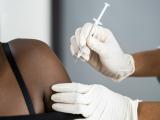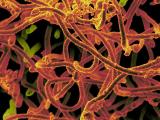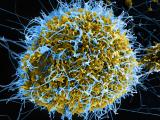Despite recent gains in battling Ebola, Sierra Leone's government today announced a new quarantine for the western part of the country, a move that it says could help meet a mid-April goal of eliminating the disease.
In other developments, more US health workers were evacuated from Sierra Leone amid new details about how they may have been exposed to the virus, and a vaccine expert pushed for governments and donors to pull together to develop vaccines against Ebola and other emerging disease threats.
Lockdown ordered for Mar 27-29
Palo Conteh, head of Sierra Leone's National Ebola Response Centre, said the lockdown will be conducted from Mar 27 to 29, similar to one it conducted in September, Agence France-Presse (AFP) reported today.
Last fall the government ordered a nationwide lockdown to help outbreak responders go door to door to identify people with symptoms and provide information about the disease. The step was criticized by some as likely to do more harm than good.
The new quarantine will affect about 2.5 million people in western Sierra Leone, where most of the country's cases are still being reported, according to the AFP report. The area includes Freetown and Bombali and Port Loko districts to the north.
In mid-February, leaders from Guinea, Liberia, and Sierra Leone met and set a goal of reducing cases to zero in 60 days, which United Nations Ebola response leaders said at the time would be extremely difficult.
Since then, cases have dramatically tapered off in Liberia, and Sierra Leone has made notable progress against the disease. However, Guinea—a country that has seen the disease rebound several times—last week reported its highest number of cases so far the year, according to a World Health Organization (WHO) update yesterday.
More aid workers return to US for monitoring
Meanwhile, two more American health workers who were potentially exposed to Ebola in Sierra Leone have been flown back to the United States for monitoring, raising the total to 17 over the past week, the Associated Press (AP) reported today, citing an official from the US Centers for Disease Control and Prevention (CDC).
The two latest workers flown home are considered at low risk and will spend the 21-day monitoring period in their homes, according to the report.
Several of the others have been positioned near specialized treatment centers, and so far only one of them has been placed in a biocontainment unit. He or she is a patient at Nebraska Medical Center who developed symptoms on Mar 15 but was better the next day, hospital officials said.
The hospital said today that the individual is now out of the biocontainment unit and has returned to active monitoring along with four others who were potentially exposed in Sierra Leone.
The exposures are linked to teams working in Sierra Leone for Partners in Health (PIH), a Boston-based aid group. A physician working with PIH in Sierra Leone was sickened by Ebola and is being treated at the National Institutes of Health (NIH) Clinical Center in Bethesda, Md., where he is in critical condition.
PIH said yesterday that four clinicians who arrived back in the United States on Mar 17 for active monitoring may have been exposed while helping one of their Sierra Leonean clinician colleagues, who later tested positive for Ebola. The clinician from Sierra Leone is being treated at a specialized health facility run by the British military.
PIH said the four workers exposed to the Sierra Leonean clinician were transferred as a precaution, and none have shown symptoms. The group added that none of 10 clinicians who cared for the sick US doctor and were brought back for monitoring have tested positive for Ebola.
Sharing vaccine development risk
Though the world has had ample time to develop an Ebola vaccine, one wasn't ready in time to help battle West Africa's outbreak, because it was too financially risky, Seth Berkley, MD, chief executive of the GAVI Alliance (Global Alliance for Vaccines and Immunization), said yesterday in a Nature editorial. Instead of blaming industry for not developing a vaccine that has little market, governments, public funders, and private donors should step up and invest in Ebola vaccines, he added.
Berkley urged groups to work on a strategy to quickly produce and distribute adequate quantities of effective vaccines when an outbreak of Ebola or any other infectious disease occurs. He said the first step is to invest in surveillance systems that can pinpoint the biggest threats and new threats.
He also said having a generic vector tested and prepared in advance that can deliver new vaccines in a new outbreak could help tackle a range of diseases. For example, he noted the four of the five Ebola vaccines in development use vectors that have been developed and tested for HIV.
"It demands a different attitude to disease control. We need to stop waiting until we see evidence of a disease becoming a global threat before we treat it like one," Berkley wrote. "Governments and donors need to invest in public-health capability, and they need to take on more of the risk of investing in vaccine development."
Case count rises
In other developments, the World Health Organization (WHO) said the totals in the Ebola outbreak have grown to 24,743 confirmed, probable, and suspected illnesses and 10,216 deaths.
The latest numbers include data as of Mar 17 for all three countries. Today's tally reflects an increase of 77 confirmed, probable, and suspected cases and 37 deaths since the WHO's update yesterday.
See also:
Mar 19 AFP story
Mar 19 AP story
Nebraska Medical Center Twitter feed
Mar 18 PIH statement
Mar 18 Nature commentary
Mar 19 WHO update


















